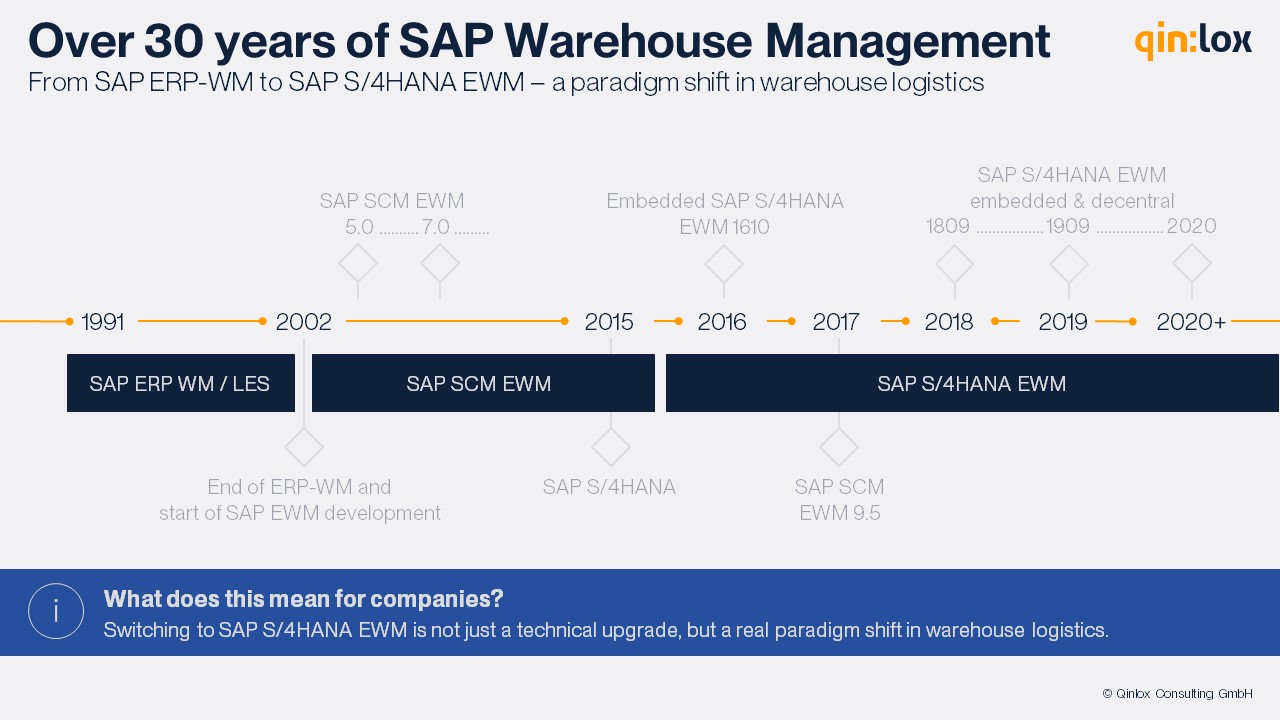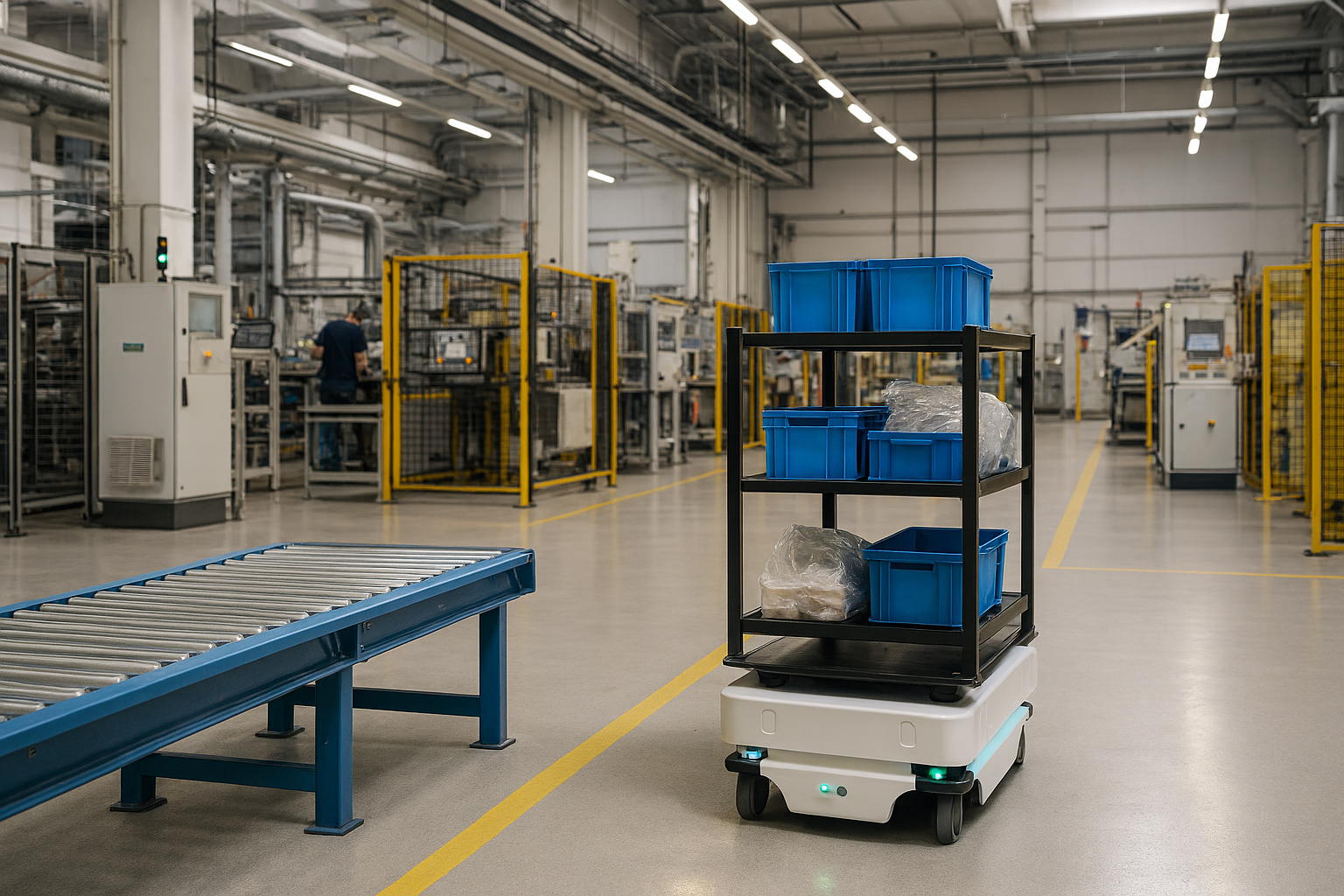From SAP WM to SAP EWM: A paradigm shift in SAP-based warehouse logistics
Migrating from SAP WM to SAP EWM means much more than just a technical upgrade. It is a fundamental change towards more flexible processes, greater transparency and modern automation.
Understanding paradigm shifts
SAP WM is increasingly reaching its limits due to automation and real-time requirements. From rigid structures in WM to flexible, rule-based processes in EWM - a new standard in warehouse logistics.
Real-Time Transparency
SAP EWM provides real-time monitoring, dashboards, and control options that go beyond what SAP WM has ever been able to offer.
Fit for the future
With SAP EWM, automation, MFS, AutoStore or AGVs can be seamlessly integrated - the basis for modern supply chains.
From WM to EWM: A paradigm shift in warehouse logistics
The requirements for modern warehouse logistics have increased rapidly in recent decades. While SAP WM was considered a reliable module for warehouse management in SAP ERP for a long time, a new generation of warehouse management systems has been established with SAP Extended Warehouse Management (SAP EWM). This article highlights the historical development from SAP WM to SAP EWM and shows why Extended Warehouse Management is now the strategic solution for companies that want to future-proof their intralogistics.
Complexity, automation, real-time: The new reality in warehouses
SAP WM was introduced in the 1990s as a module in SAP R/3 and offered basic functions for inventory management and control of warehouse processes. With growing complexity in warehouse logistics, for example through automation, real-time data and increasing requirements for transparency, SAP WM was increasingly reaching its limits.
Requirements of modern warehouse management systems
- Increasing complexity due to e-commerce, omnichannel, returns.
- Automation through conveyors, AutoStore, AGVs and robotics.
- Transparency & real-time data for monitoring and control.
- Integrate with SAP S/4HANA, IoT, MES, and TMS.
- Flexible process design and mobile working
SAP EWM as an answer to modern warehouse requirements
SAP EWM was introduced in 2007 as a standalone product and offers significantly expanded functionalities: cross-docking, yard management, integration of automated warehouse technology and flexible control of complex warehouse structures. Since the advent of SAP S/4HANA, SAP EWM has also been available as an embedded solution — fully integrated into the S/4HANA system landscape
Development from SAP WM to SAP EWM at a glance

Timeline & milestones
- 1990s: Introduction of SAP WM in SAP R/3 with a focus on inventory management and movements
- 2000s: Increasing requirements for warehouse processes and automation
- 2007: Introduction of SAP EWM as a standalone product
- 2015+: Decentralized EWM systems with interfaces to SAP S/4HANA
- today: Embedded SAP EWM in S/4HANA with full integration and real-time data processing
Discontinuation of SAP WM
SAP WM will be discontinued in 2027 - by then, at the latest, the switch to SAP EWM will be unavoidable.
Companies that act early on secure competitive advantages through modern, automated and transparent warehouse processes.

Technical and functional differences: SAP WM vs. SAP EWM
The key benefits of SAP EWM
- functionality: Cross-docking, slotting, yard management, sequencing.
- Flexibility & scalability: Adaptable to all warehouse sizes and business models.
- Real time & transparency: Monitoring and reporting in real time.
- Automation & integration: SAP MFS, robotics, IoT.
- S/4HANA compatibility: Embedded or decentralized.
- Future security: SAP WM is being replaced, EWM is the strategic solution.
What to consider when switching (migration & best practices)
- Analysis of existing WM processes and customizing
- Opting for embedded or decentralized architecture
- Cleansing and preparing master data
- Using standard EWM functions instead of adopting workarounds
- Completion of open World Cup documents before migration
- Restructuring user roles and authorizations
- Inspection and adjustment of interfaces
- Comprehensive testing and training of employees
- Securing inventory data during migration
- Continuous optimization after go-live
Common challenges and how to overcome them
- High migration costs: Structured planning, clean process planning and best practices ensure that complexity remains manageable.
- Costs and project scope: The introduction of SAP EWM requires investments, but these pay off in the medium to long term through efficiency improvements and greater transparency.
- Employee acceptance: Training, clear communication and targeted change management are crucial for involving users at an early stage and reducing resistance.
- System downtime: Clean go-live management with tests, pilot phases and fallback strategies can minimize disruptions in day-to-day business.
- Inventory accuracy: Thorough cleaning and validation of master data before migration is essential to avoid errors and discrepancies in the new system.
FAQs
Do you have any questions? We have compiled the most important answers for you in the following FAQs. If your question is not listed, please feel free to contact us directly.
SAP WM refers to the classic Warehouse Management module within SAP ERP R/3, which has been in use since the 1990s. The term SAP WMS is often used interchangeably and generally stands for "Warehouse Management System." SAP EWM, short for "Extended Warehouse Management," is SAP’s modern solution offering advanced features, real-time integration, and full embedding within SAP S/4HANA.
Mainstream support for SAP WM will end in 2027. However, companies can extend maintenance until 2030 for an additional fee. In the long run, transitioning to SAP EWM is inevitable.
Embedded SAP EWM runs directly within SAP S/4HANA. It doesn’t require external interfaces and offers tight integration with lower operating costs. Decentralized SAP EWM, on the other hand, operates on a separate instance and is ideal for high process loads or complex scenarios, offering greater flexibility and independence.
Yes. SAP S/4HANA Basic EWM is a streamlined version designed for smaller warehouses and less complex processes. Companies can upgrade to the full Advanced EWM functionality at any time as their needs evolve.
SAP WM struggles to meet modern requirements such as automation, real-time transparency, and complex warehouse structures. Since SAP no longer develops WM strategically, SAP EWM is the future-proof alternative.
SAP EWM supports advanced features like cross-docking, slotting, wave management, yard management, and integration with warehouse automation technologies. Businesses benefit from increased flexibility, automation, and transparency in their warehouse operations.
Key success factors include a thorough analysis of current processes, cleansing of master data, a clear migration strategy, and extensive testing. Equally important are user training and change management to ensure smooth adoption across the organization.
Conclusion
The development from SAP WM to SAP EWM shows the change from a classic warehouse management system to a highly flexible, integrated and sustainable solution. Companies benefit from better automation options, increased transparency and more efficient processes in their intralogistics. SAP EWM is not just a technological upgrade, it is a strategic step towards digital warehouse logistics and ensuring competitiveness.









